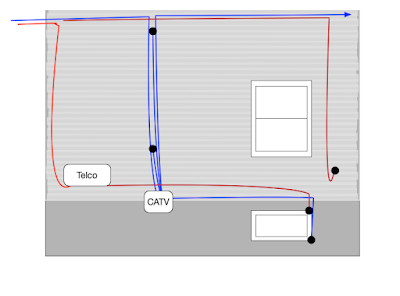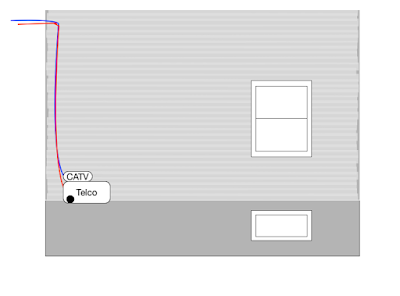The outside of my house had an ugly nest of telephone and cable TV wires. These wires were installed decades ago (between 1925 and 2005) and no one cared how it looked. Ugly is a problem from reasons other than aesthetics: reliability and understandability. My mission: Pretty up any potentially useful wiring, and remove any useless house wires.
 |
| Diagram 1: Wires Everywhere |
The east side of my home had a lot of wires, as seen in Diagram 1. There was a telephone feed (red) that went to a telephone demarcation box, and then traveled along the building, where it finally popped in by the basement window. In addition, there was a long-abandoned telephone feed (1920s?) that worked its way across the building and into to the basement.
The cable TV wiring (blue) was bulkier and uglier. It followed a slightly different route. The cable TV
was also fed into multiple rooms by stringing it up along the facade.
I gave up using cable TV and wired telephone over a decade ago, but I don't
necessarily want to rip out wiring that was properly installed
and that could be useful in the future. Therefore, my approach is to
keep all the wires that run properly within the walls and eliminate the
rest. And I'll keep the feeds from the street in place, just
in case I ever want restore these legacy services.
Removing "Bad" House Wiring
Since the telephone and cable TV services were "disconnected" from the service providers' billing prospective, the first thing I did was to physically disconnect the cables from their demarcation point. That means I kept the telephone and cable tv company wall boxes in place, along with their wiring from the street, but the feeds on the house side was disconnected. Now I could freely and safely go after the wires on the house.
But before ripping things out, I wanted to make sure I was removing the right coax cables. I used an inexpensive cable TV tester to verify the ends of each cable, and labelled them with some tape. After all, the worse thing to do would be to mistakenly cut a cable I wanted to keep.
After identifying each cable, I used some diagonal cutters to clip the cables at the wall, and then went inside the house and yanked the cables through. I then had 5 holes in the facade to plug up, so I squirted in some insulating foam and patched the holes using outdoor patch filler.
Cleaning Up the Companys' Work
The next thing to do was to clean up the service providers' demarcation boxes. I opened up the boxes and unscrewed them from the wall. I then repositioned the boxes in a useful and aesthetically pleasing manner. I also drilled a new hole in the facade, adjacent to the boxes, so that the wires could enter the basement without traversing the outside of the building.
Results
This project was easy, but it had a significantly positive impact. The mass of wires and cables is gone. Now there is one simple cable path for the cable TV and telephone wires, and one hole in the facade for the cables to enter the building. There are no other cables strung up on the outside of the building.
 |
| Diagram 2: Much improved wiring. |
More importantly, I lost nothing: the cables were not in active use, and if I ever did want to restore service, all I would have to do is call up one of the companies and have them turn on service. For the three rooms that lost their cable TV jacks: it is easy to feed any location of the building by pulling wires through the walls with a steel fish tape. But that's a topic for another day.